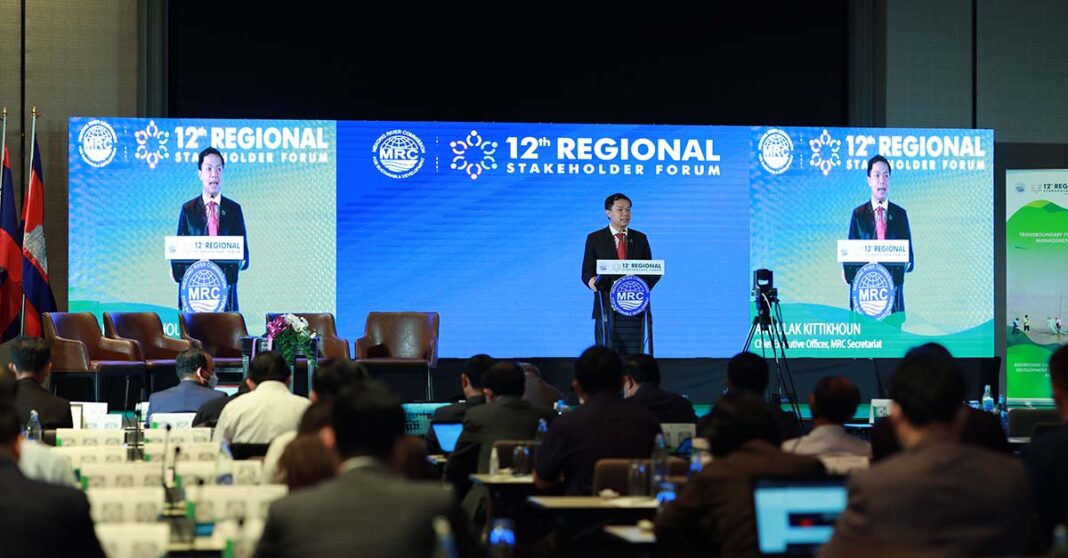The Mekong River Commission (MRC) has urged the six countries along the Mekong River to maximize the advantages of hydropower projects while minimizing their impact on the environment and the tens of millions of residents living in the basin.
The MRC made the request during the Mekong River Commission’s 12th Regional Stakeholder Forum, held on 29 June.
At the heart of this is the Hydropower Development Strategy (SHDS), which the MRC Council approved last November. It now expects the many developers of these cascade-dam systems to share more information about their operations with the MRC, among developers themselves, and the public.
For example, advanced warning about any planned water release or withholding would enable riparian communities to better prepare for a sudden change. Vietnam was cited as an example, with its data-sharing plan for hydropower projects.
“This is the first time where the MRC is developing cooperation mechanisms for information sharing and operational coordination of water infrastructure projects – in this case, cascade dams,” said Dr. Anoulak Kittikhoun, the MRC Secretariat CEO, in welcoming the RSF audience, which included some 250 people.
“The mechanism will be essential for the management of power production, environment, and flood and drought impact mitigation.”
Besides the SHDS, the stakeholders witnessed another milestone in regionwide cooperation to solve transboundary challenges, which extend beyond hydropower. (MRC studies have documented the exacerbated damage done by climate change, through floods and drought, to the fisheries, to sediment, to the wetlands – and the hardship brought to fishing and farming families.)
Indeed, the Forum event also launched a landmark Joint Study between the four MRC Member Countries – Cambodia, Lao PDR, Thailand and Viet Nam – and the LMC Water Resource Cooperation (including Myanmar and China), where 11 hydropower projects sit along the Lancang, as the Mekong is known in China. The Study of those cascade dams will detail the “changing patterns of hydrologic condition” and promises to produce “adaptation and mitigation strategies.”
Any enhanced information sharing with China is significant, just as in 2020, when China agreed to share its dry season data – when water is scarcer – in addition to its wet season data.
“This is a necessary study, in a time when divergent perspectives and understanding on the causes and conditions of the changing pattern of hydrological conditions can foster mistrust and hinder cooperation,” Dr. Anoulak explained.
Since so many issues like this are sensitive and far-reaching, the CEO told the diverse audience – which joined in-person and online, via the MRC’s social media channels – “We would like to engage with you and ensure your expertise and views are taken into account.”
From the Chinese side, the Joint Study can help make this waterway “a river of friendship, cooperation and prosperity,” said Hao Zhao, Secretary-General of the Beijing-based LMC Water Center, which has partnered with the MRC in this Study.
Mutual challenges related to development and climate change “have enabled the riparian countries to raise awareness of cooperation and join hands to find a new path of rational and sustainable utilization of water, to solve and respond to difficulties and challenges for Basin development,” Hao said. “Information sharing is very critical for the success of this Study and for river management.”
Beyond the Joint Study and the sustainable hydropower strategy, stakeholders discussed other pressing issues, such as transboundary fisheries, flood and drought forecasting, and the nexus, and gender dimensions.
On fisheries, the Mekong is reportedly one of the world’s “most productive” rivers, harvesting some two million tons of fish each year. Yet, they’ve been dramatically affected by the combination of dams, climate change and overfishing, which impact fish migration, spawning and maturation process. Managing this situation, the forum suggests, will require even greater cooperation among government policy-makers, dam owners and fishing communities – with the intergovernmental MRC as the coordinating agency.
As for flood and drought – which grow more extreme and devastating over the years – they require advanced technology and timely warning. While progress is clear, stakeholders agree that more should be done: to increase the frequency of flood forecasting, as early as possible and with an extended time period; to build more monitoring stations along the Mekong and its tributaries; and more importantly, to make meaningful use of the information.
Lastly, on gender, Elizabeth Thipphawong, a Civil Society Specialist with the World Wildlife Fund, reminded the audience of the need to inject gender and social inclusion into their considerations, with everything from the obligation to hire women for design, engineering and other work opportunities, to weighing how Southeast Asian women are uniquely affected by hydropower development or climate change.
In summarizing the Forum’s key takeaways, Dr. Anoulak reiterated that there is greater recognition and will to tackle “our Basin’s common challenges, even greater upstream-downstream cooperation, and the need to further protect our people and our environmental assets. And these bode well for cooperation.”



